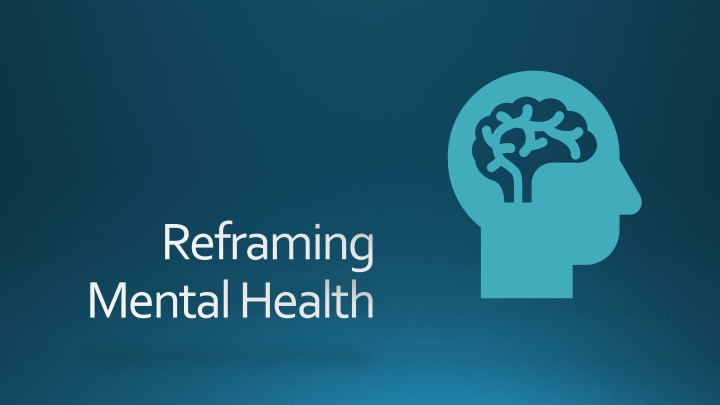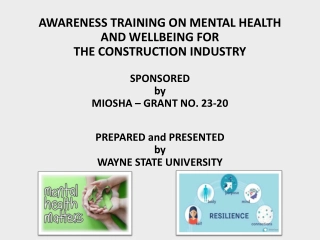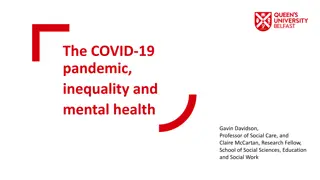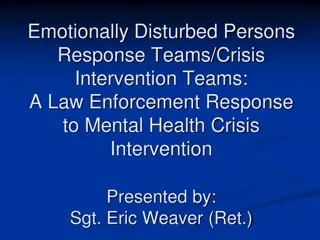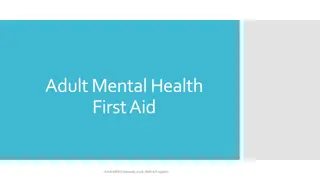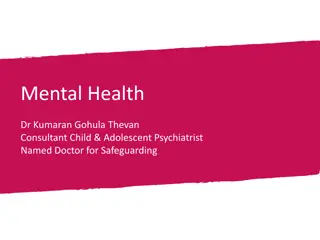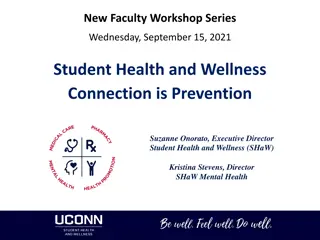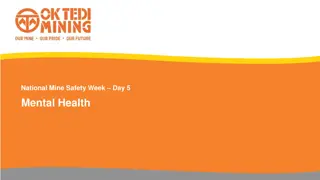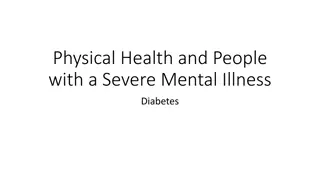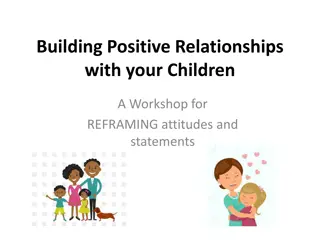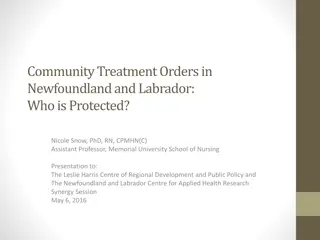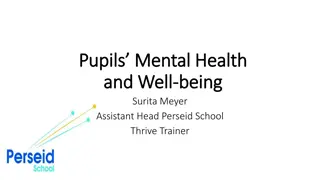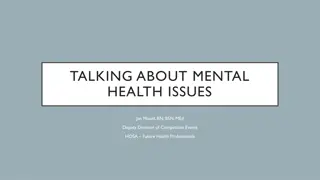Reframing Mental Health Issues: Overview
Brief history, stigma, signs, and broaching of mental health issues. Learn to recognize stigma, signs, and symptoms, and feel confident addressing mental health topics. Dive into reframing mental health perspectives, covering trephination, asylums, and current views. Understand the definition of mental health and the impact of stigma on individuals. Gain insights into mental illnesses and the importance of viewing mental health as integral to overall well-being.
Download Presentation

Please find below an Image/Link to download the presentation.
The content on the website is provided AS IS for your information and personal use only. It may not be sold, licensed, or shared on other websites without obtaining consent from the author.If you encounter any issues during the download, it is possible that the publisher has removed the file from their server.
You are allowed to download the files provided on this website for personal or commercial use, subject to the condition that they are used lawfully. All files are the property of their respective owners.
The content on the website is provided AS IS for your information and personal use only. It may not be sold, licensed, or shared on other websites without obtaining consent from the author.
E N D
Presentation Transcript
Reframing Mental Health
Brief history of mental health Agenda Mental health stigma Signs and symptoms Broaching the subject
Objectives Recognize mental health stigma (in yourself and others) Acknowledge signs and symptoms of mental health disorders Feel confident broaching the subject of mental health issues if needed or appropriate NOT Diagnose yourself or others
What is Reframing? Purpose is to see an issue from a different perspective Notice and acknowledge
Trephination (drilling into the skull) Asylums (separation from society) State mental hospitals (trying to cure) Mental health issues have physical causes Mental health issues are psychological Psychotropic medications De-institutionalization Brief History of Mental Health
Mental Health: State of well-being in which every individual realizes his or her own potential, can cope with the normal stress of life, can work productively and fruitfully, and is able to make a contribution to her or his community. Mental Health Stigma - World Health Organization Definition of Mental Health
Mental Health Stigma Mental Illness Diagnosable medical illness Represents a change from prior function Affects a person s thinking, emotional state, and behavior Disrupts a person s ability to Work Carry out daily activities Engage in satisfying relationships
Mental Health Stigma According to the World Health Organization, onein four people in the world will be affected by mental or neurological disorders at some point in their lives. Mental illnesses are brain-based disorders Character issue/moral issue vs. mental health issue Mental health vs. physical health Mental health IS physical health?
Example You learn that a new co-worker s young son yells, swears, threatens people, gets kicked out of class all the time, and presents multiple other odd behaviors. What immediate thoughts do you have of the son and his parents (your new co-worker)?
Example You learn that the boy has a brain tumor that significantly impacts his ability to control his body and his emotions. What are your immediate thoughts/feelings now? Are they different?
Example Instead, you learn the boy has been diagnosed with a mood disorder, ADHD, anxiety, and also struggles with various sensory vulnerabilities What are your immediate thoughts/feelings now? Are they different?
Example What if these behaviors were instead that of your co- worker, not her son? What if these behaviors were that of a client? What if these behaviors were suddenly yours?
Signs and Symptoms Signs What we can observe Symptoms What the person experiences as a result of the illness
Signs and Symptoms Depression May occur only once during a person s life People typically have multiple episodes over a lifetime During these episodes, symptoms occur most of the day, nearly every day For many people, symptoms usually are severe enough to cause noticeable problems in day-to-day activities, such as work, school, social activities or relationships with others. Some people may feel generally miserable or unhappy without really knowing why
Signs and Symptoms of Depression Signs what we may see Weight change Symptoms what someone may feel Sadness/anxiety Hopelessness Withdrawal from others Low energy Helplessness Irritability Sleep disturbance Thoughts of death and suicide Changes in self care/appearance Appetite change Personality change Headaches Tearfulness Pessimism Indecisiveness/confusion Loss of sexual desire Disorganization Unexplained aches and pains Forgetfulness Self-criticism
Depression Older Adults Depression is not a normal part of growing older, and it should never be taken lightly Symptoms of depression may be different or less obvious in older adults, such as: Memory difficulties or personality changes Physical aches or pain Fatigue, loss of appetite, sleep problems or loss of interest in sex not caused by a medical condition or medication Often wanting to stay at home, rather than going out to socialize or doing new things Suicidal thinking or feelings, especially in older men
Signs and Symptoms General Anxiety Disorder People with generalized anxiety disorder (GAD) display excessive anxiety or worry about a number of things such as personal health, work, social interactions, and everyday routine life circumstances. most days for at least 6 months Causes significant problems in all areas of life
Signs and Symptoms of Anxiety Signs what we may see Physical tension/fidgeting Impatience Irritability Anger Difficult completing projects Avoidance of situations Panic Symptoms what someone may feel Sadness/anxiety Low energy Sleep disturbance Appetite change Headaches Pessimism loss of sexual desire Unexplained aches and pains Hopelessness Helplessness Thoughts of death and suicide
Signs and Symptoms Panic Disorder People with panic disorder have recurrent unexpected panic attacks. Panic attacks are sudden periods of intense fear that come on quickly and reach their peak within minutes. Attacks can occur unexpectedly or can be brought on by a trigger, such as a feared object or situation. People with panic disorder often worry about when the next attack will happen and actively try to prevent future attacks by avoiding places, situations, or behaviors they associate with panic attacks. Worry about panic attacks, and the effort spent trying to avoid attacks, cause significant problems in various areas of the person s life, including the development of agoraphobia.
Signs and Symptoms Panic Attack (continued) Heart palpitations, a pounding heartbeat, or an accelerated heartrate Sweating Trembling or shaking Sensations of shortness of breath, smothering, or choking Feelings of impending doom Feelings of being out of control
Signs and Symptoms Psychosis The word psychosis is used to describe conditions that affect the mind, where there has been some loss of contact with reality. During a period of psychosis, a person s thoughts and perceptions are disturbed and the individual may have difficulty understanding what is real and what is not.
Signs and Symptoms of Psychosis Signs what we may see Isolation/withdrawal Blunted/flat or inappropriate emotion Suspiciousness Reduced energy and motivation Unusual/inappropriate comments Disruptive Unable to complete tasks Symptoms what someone may feel Sleep disturbances Odd ideas Altered sense of self, others, and the world Unusual perceptual experiences (sound, color, smell) Hallucinations Delusions Thinking difficulties
Signs and Symptoms of Suicide Signs what we may see Threatening to hurt or kill oneself Symptoms what someone may feel Sadness/anxiety Unexplained aches and pains Seeking access to means Low energy Hopelessness Talking or writing about death, dying, or suicide Sleep disturbance Helplessness Appetite change Acting recklessly/risky activities Thoughts of death and suicide Headaches Pessimism Loss of sexual desire
Broaching the Subject I ve noticed [change in behavior sign or symptom]. I m here to talk if there s anything going on. You haven t seemed like yourself lately let me know if there is anything I can do. Suicide Be direct don t sugarcoat Are you having thoughts of suicide? Are you thinking about killing/harming yourself? Do you have a plan? What is your plan? Do you have the means to carry out your plan? Consider that an awkward conversation is better than saying I should have said something after the fact.
Broaching the Subject DO DON T Be judgmental Agree to keep anything a secret Project your own experiences with mental health issues onto others Let the person know you are concerned and willing to help Discuss your observations I ve noticed Appear confident
Reframing Mental Health What one stereotype could you change through your own thoughts or actions?
